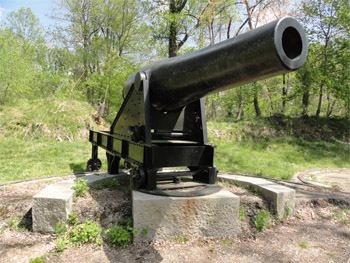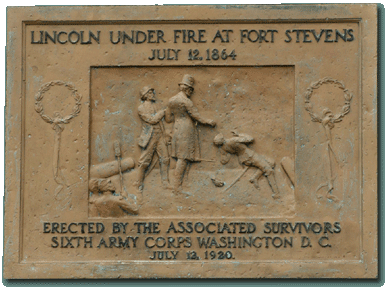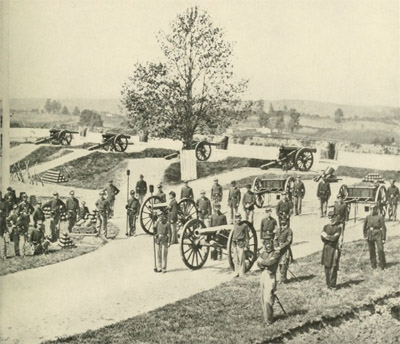 |
The Defenses of Washington DC
|
|
 |
On June 20 1783, around 400 US Army soldiers mobbed Independence Hall in Philadelphia, Pennsylvania, while Congress was in session. These soldiers demanded payment for their soldiering, which they felt was long overdue (and they were most likely absolutely correct), but Congress didn't have a big treasure chest full of money sitting around, so they couldn't fork over the dough even had they wanted to. Which they didn't.
What Congress did want was for the Pennsylvania authorities to forcibly remove these protesters, but the Pennsylvania Executive Council, headed by President of Pennsylvana, John Dickinson (1732-1808), refused. Congress left for Princeton, New Jersey, on June 21, where they hoped to be better protected from such unseemly protests.
|
|
 A 15-inch Rodman gun at Fort Foote, Maryland A 15-inch Rodman gun at Fort Foote, Maryland |
 |
Congress spent the next few years zipping from Princeton to New York City and then back to Philadelphia, but it was plain that a different solution was needed for the capital city of the US. The Residence Act was passed in 1790, which approved the creation of a national capital on the Potomac River. Maryland and Virginia donated a total of 100 square miles of land to this worthy enterprise (Virginia whined until it got it's "donated" land back in 1846: Thanks, slavery!).
The District of Columbia remained a sleepy, provincial little mosquito-infested swampy burglet for the next several decades (notwithstanding the brief excitement of being burned down by the British
|
|
|
during the War of 1812 (1812-1814)), until several US states seceded from the union in 1861, kicking off the US Civil War (1861-1865). The war's first major battle at Manassas (July 21 1861) didn't result in the lightning victory of which the Union was confident, and as the troops in blue limped back into Washington DC, the impressively moustachioed gentlemen in government service suddenly realized that they were almost completely defenseless.
 Fort Washington, guarding Washington DC's southern approaches on the Potomac Fort Washington, guarding Washington DC's southern approaches on the PotomacFort Washington had been completed in 1824, mainly as a reaction to the British destruction of Washington DC during the War of 1812. Twelve miles south of DC, Fort Washington is a big, scary fort, and completely commands the Potomac River, but in 1861 it was the only substantial defensive structure standing between the marauding Confederate army and DC...and the Army of Northern Virginia would be unlikely to cooperate by trying to sail up the Potomac when they could just as easily walk to DC from Virginia. US President Abraham Lincoln (1809-1865) organized the Department of the Potomac on August 4 1861: This department would be tasked with gathering what was needed to protect the city. Over the next few years Washington DC's population skyrocketed (1860 census: 75,000 residents. 1870 census: 132,000) as the city became the focal point for running the war and as a result of the massive fortification effort.
|
 Abraham Lincoln bemusedly watches as a Union soldier is cut down before him, as future Supreme Court Justice Oliver Wendell Holmes (1841-1935) tries desperately to drag him to safety; as presented on a monument at Fort Stevens Abraham Lincoln bemusedly watches as a Union soldier is cut down before him, as future Supreme Court Justice Oliver Wendell Holmes (1841-1935) tries desperately to drag him to safety; as presented on a monument at Fort Stevens |
 |
Countless escaped slaves made their way to Washington DC and found themselves frantically digging as part of the effort to build a ring of fortifictions around the city, in a fate that must have been way better than slavery.
The defenses of Washington would, by 1865, consist of 68 forts. 93 detached artillery batteries and some 20 miles of rifle pits, plus covered walkways and various other entrenchments filled the gaps between the forts, which were built on hills all around the city: All of the fortifications were connected by communications trenches. All of this bristling pointiness made Washington DC one of the most heavily defended cities in the world...but was it bristly enough?
|
|
Yes. The only time the defenses of Washington were tested was on July 11-12 1864, when Confederate Lieutenant General Jubal Early (1816-1894) led some 20,000 men in an attempt to attack Washington through what he believed was a lightly-defended defensive ring. Most of the men who had been in the defenses of Washington had indeed been stripped away to aid in the ongoing attack on Petersburg, but when Early's troops poked at and around Fort Stevens (one of the northernmost forts in the ring), they found themselves confronted with heavy artillery and musket fire.
Only seven miles from the White House, Abraham Lincoln became the second (and fortunately last) sitting US President to come under enemy fire when he cheerfully visited Fort Stevens on both days of the attack (the first being James Madison (1751-1836), who tried to lead dispirited militia in the defense of Washington when the British came a-callin' in 1814). The Confederacy ultimately found itself unable to break through the ring of defenses around Washington DC.
|
In 1919 the Fort Circle plan was developed by the Commissioners of the District of Columbia: A series of leafy green parks, based on the ring of Civil War defenses, circling the capital and connected by dedicated roads, was envisioned as a government-owned place for Washington's citizens to easily escape the confines of the city. All of the property on which the forts had been built had of course been turned back over to their owners after the war, however, and the project was abandoned.
Several other attempts to unify the former defensive works in this fashion were made over the next few decades: The Civilian Conservation Corps got involved in the 1930's and did some upkeep of the properties that had been bought back by the government. US Presidents Harry S. Truman (1884-1972) and John F. Kennedy (1917-
|
 |
 Fort Stevens in 1865. Surely those troops could be doing something more productive than just standing there. Fort Stevens in 1865. Surely those troops could be doing something more productive than just standing there. |
|
1963) both took an interest in re-establishing the Fort Circle, but particularly by the time of the Kennedy administration, Washington DC had grown past the boundary that the Civil War defenses defined, and there were by then plenty of roads connecting the forts, if not the placid ring that had been envisioned. Today there are a number of monuments around Washington DC that emanate from its Civil War defenses. Fort Ward in Alexandria features a rebuilt pointy bastion (the pointy bastion of a starfort is my absolute favorite kind of bastion, so I visited Fort Ward in 2012: Click here to see the pix I took there in Starforts.com's Starforts I've Visited section), and Fort Stevens is represented by a battery of guns. I did my level best to visit Fort Stevens in the summer of '12 as well, but found myself confounded by both a dizzying array of residential streets and my unfailing inability to find things. I was able to find Fort Totten, another fort in the ring, but as is likely the case with most of the remaining forts, little of it remains: Some relatively impressive earthen berms, completely overgrown with unattractive vegetation, are all that are left to explore.
|
|
|
|
|
|
 |




